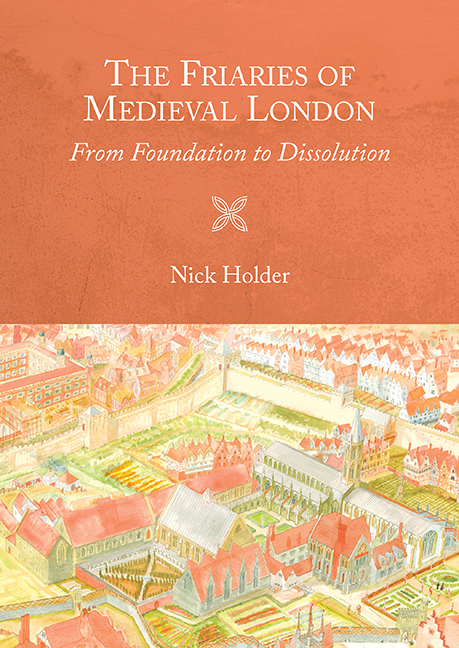Book contents
- Frontmatter
- Contents
- List of Illustrations and Tables
- Contributors
- Acknowledgements
- Abbreviations
- Introduction
- Part I The Nine London Friaries
- 1 The First Black Friars in Holborn, c. 1223–86
- 2 The Second Black Friars, 1275–1538
- 3 The Third Black Friars at St Bartholomew's, 1556–9
- 4 Grey Friars, 1225–1538
- 5 White Friars, c. 1247–1538
- 6 Austin Friars, c. 1265–1538
- 7 Crossed Friars, c. 1268–1538
- 8 Sack Friars, c. 1270–1305
- 9 Pied Friars, 1267–1317
- Part II The London Friars and their Friaries
- Conclusions
- Timeline
- Bibliography
- Index
- Miscellaneous Endmatter
5 - White Friars, c. 1247–1538
from Part I - The Nine London Friaries
Published online by Cambridge University Press: 16 May 2018
- Frontmatter
- Contents
- List of Illustrations and Tables
- Contributors
- Acknowledgements
- Abbreviations
- Introduction
- Part I The Nine London Friaries
- 1 The First Black Friars in Holborn, c. 1223–86
- 2 The Second Black Friars, 1275–1538
- 3 The Third Black Friars at St Bartholomew's, 1556–9
- 4 Grey Friars, 1225–1538
- 5 White Friars, c. 1247–1538
- 6 Austin Friars, c. 1265–1538
- 7 Crossed Friars, c. 1268–1538
- 8 Sack Friars, c. 1270–1305
- 9 Pied Friars, 1267–1317
- Part II The London Friars and their Friaries
- Conclusions
- Timeline
- Bibliography
- Index
- Miscellaneous Endmatter
Summary
THE Carmelites or White friars began as a group of hermits living on Mount Carmel in Palestine in the late twelfth or early thirteenth century. The Arab reconquest of the Holy Land in the thirteenth century pushed these hermits back towards Europe, and they established Carmelite provinces in Cyprus, Sicily and England, the latter in 1242. This change of location gradually brought about a change in purpose as the hermits became friars, with a new mendicant Rule authorised by Pope Innocent IV in 1247. The early Carmelites brought their eremitic lifestyle with them to Europe, setting up small rural monasteries, for example, at Hulne in Northumberland and Aylesford in Kent. But the change of status from hermit to friar soon brought about a move from country to town and most Carmelite houses from the second half of the thirteenth century onwards were urban friaries. The Carmelite friars became known as White friars in England thanks to the colour of their cloak, the main distinguishing feature when meeting a Carmelite outside his friary.
The English White friars probably established their London house in the late 1240s, although the evidence is not as clear as one would like. The late sixteenth-century historian John Stow, citing the early sixteenth-century Carmelite historian John Bale, says that the London White Friars was founded by the returning crusader Richard de Grey in 1241, and de Grey is also credited in a papal bull of 1254. Modern scholars have, however, suggested that his foundation could well post-date the order's new mendicant Rule of September 1247, which encouraged the new friars to look to the towns. Other evidence shows that the papal authorities were negotiating with the bishop of London in 1246 about the establishment of a friary; furthermore, Carmelite lists of houses place London chronologically before Cambridge, the latter given formal permission in November 1247. Our best guess is therefore to say that de Grey gave the friars their first plot of land for the London friary in about 1247.
The friary became a successful urban institution, housing sixty to eighty friars in the first half of the fourteenth century. Unusually among London's monastic houses, the numbers seem to have recovered quickly after the Black Death with seventy-eight friars identified here at the end of the century.
- Type
- Chapter
- Information
- The Friaries of Medieval LondonFrom Foundation to Dissolution, pp. 97 - 118Publisher: Boydell & BrewerPrint publication year: 2017

